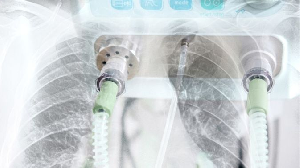
Dieuwertje Ruigrok, Lilian J. Meijboom, Esther J. Nossent, Anco Boonstra, Natalia J. Braams, Jessie van Wezenbeek, Frances S. de Man, J. Tim Marcus, Anton Vonk Noordegraaf, Petr Symersky, Harm-Jan Bogaard
European Respiratory Journal 2020 55: 2000109; DOI: 10.1183/13993003.00109-2020
Abstract
Aim Haemodynamic normalisation is the ultimate goal of pulmonary endarterectomy (PEA) for chronic thromboembolic pulmonary hypertension (CTEPH). However, whether normalisation of haemodynamics translates into normalisation of exercise capacity is unknown. The incidence, determinants and clinical implications of exercise intolerance after PEA are unknown. We performed a prospective analysis to determine the incidence of exercise intolerance after PEA, assess the relationship between exercise capacity and (resting) haemodynamics and search for preoperative predictors of exercise intolerance after PEA.
Methods According to clinical protocol all patients underwent cardiopulmonary exercise testing (CPET), right heart catheterisation and cardiac magnetic resonance (CMR) imaging before and 6 months after PEA. Exercise intolerance was defined as a peak oxygen consumption (V′O2) <80% predicted. CPET parameters were judged to determine the cause of exercise limitation. Relationships were analysed between exercise intolerance and resting haemodynamics and CMR-derived right ventricular function. Potential preoperative predictors of exercise intolerance were analysed using logistic regression analysis.
Results 68 patients were included in the final analysis. 45 (66%) patients had exercise intolerance 6 months after PEA; in 20 patients this was primarily caused by a cardiovascular limitation. The incidence of residual pulmonary hypertension was significantly higher in patients with persistent exercise intolerance (p=0.001). However, 27 out of 45 patients with persistent exercise intolerance had no residual pulmonary hypertension. In the multivariate analysis, preoperative transfer factor of the lung for carbon monoxide (TLCO) was the only predictor of exercise intolerance after PEA.
Conclusions The majority of CTEPH patients have exercise intolerance after PEA, often despite normalisation of resting haemodynamics. Not all exercise intolerance after PEA is explained by the presence of residual pulmonary hypertension, and lower preoperative TLCO was a strong predictor of exercise intolerance 6 months after PEA.
Despite normalisation of haemodynamics, exercise capacity remains abnormal in two-thirds of chronic thromboembolic pulmonary hypertension patients after pulmonary endarterectomy. Not all exercise intolerance is explained by the presence of residual PH. http://bit.ly/2Wie64s
Footnotes
-
This article has supplementary material available from erj.ersjournals.com
-
Conflict of interest: D. Ruigrok has nothing to disclose.
-
Conflict of interest: L.J. Meijboom has nothing to disclose.
-
Conflict of interest: E.J. Nossent has nothing to disclose.
-
Conflict of interest: A. Boonstra has nothing to disclose.
-
Conflict of interest: N.J. Braams has nothing to disclose.
-
Conflict of interest: J. van Wezenbeek has nothing to disclose.
-
Conflict of interest: F.S. de Man has nothing to disclose.
-
Conflict of interest: J.T. Marcus has nothing to disclose.
-
Conflict of interest: A. Vonk Noordegraaf reports grants from Actelion, GSK, Pfizer and Bayer, outside the submitted work.
-
Conflict of interest: P. Symersky has nothing to disclose.
-
Conflict of interest: H-J. Bogaard reports grants from Actelion, GSK, Pfizer, Bayer and Therabel, outside the submitted work.
- Received January 18, 2020.
- Accepted March 9, 2020.
- Copyright ©ERS 2020














